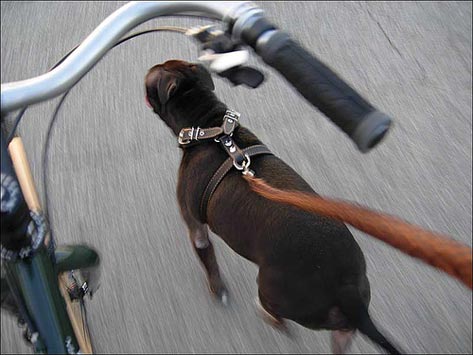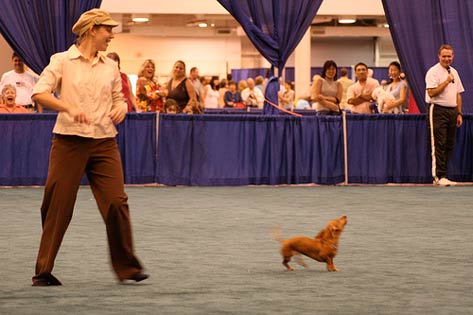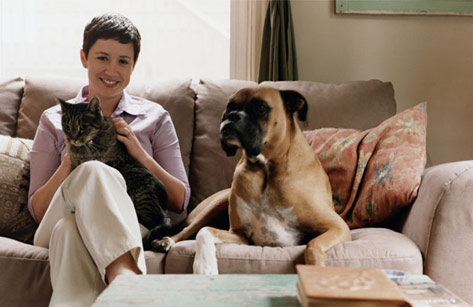

Are you a biker who feels guilty every time you buckle your helmet on and head out the door as your dog whines sadly, knowing that you’re going off to have fun without her? Maybe you have been worried that your dog can’t keep up with you, or that her leash will get caught in the bike wheels, but there are ways to include your dog in the ride. Here are a few of the basics.
If your dog actually has the energy and stamina to trot along side of you as you bike, great! This is a perfect way to get exercise. But even if your dog appears to be in the best of health, you should have your veterinarian check your dog over before starting a new exercise routine like jogging -- which is essentially what this is. You will want to be sure that your dog doesn’t have any underlying conditions that could be worsened by strenuous exercise. Also, if your dog is overweight, jogging is usually not the best way to begin a new routine; it needs to be built up to with a regular walking routine first.
Once your dog has been cleared for exercise, you can buy the necessary gear. Essentials include a non-tangling lead; a body harness (attaching the lead to only a neck collar could be dangerous; attach the lead to a fitted body harness instead); a brightly colored reflective vest for your dog (you may also apply reflective tape to your dog’s vest); blinking lights for your dog and bike (you can get a collar that has lights embedded in it, or use an attachable tag sized light); a small first aid kit for little nicks that can occur; an extra lead for detaching your dog from the bike to do other things; and water bottles for you and your dog.
Extras that can make the ride more enjoyable are dog booties -- hiking grade to protect your dog’s feet from jagged objects and from slippery or hot (or cold) concrete; a bike lead “baton” that can be attached to the body of the bike to hold the lead -- and the dog -- away from the bike’s wheels (as opposed to holding the lead up by the handlebars); reflective rain gear or cold weather cover-ups for inclement weather; and a dog backpack so your dog can carry her own water bottle and treats.
If your dog has never been around your bike before, start off by walking the bike along with the dog -- you on one side and your dog on the other -- just to get her acquainted with being attached to the bike. If possible, try to use paths that are soft, like grassy or dirt paths.
As you do these practice “runs,” begin using the commands you will be using for biking, such as for slowing down, making turns, stopping, or for bringing your dog’s attention back to you when she is distracted by something. Try (as best as possible) to choose words that are specific to you and your dog so that she is not confused by hearing other people use the words. Over time she will become accustomed to these new commands and will be able to anticipate your actions
Don't expect your dog to be able to run for long distances in the beginning. Just like us, dogs need some time to acclimate to an exercise routine. Start off by riding at a walking speed on an easy path for a short distance. As she gets used to this over a week or two, build up to a trotting speed after a ten minute warm-up walk. Observe your dog at all times and stop immediately if she appears tired, is panting heavily, drooling excessively, or loses coordination (this may be signs of hyperthermia). If she seems to be slowing down, stop and allow her to rest and have a drink.
Remember, this isn't a race. Pedal at a pace that will allow your dog to keep up easily. Watch your dog closely. Any distraction (another dog, animal, or person) that causes your dog to pull away can cause both of you to take a tumble.
During the ride and when you take breaks, remember to give your dog lots of praise for being a good biking partner.
If you are biking with more than one dog, it might be best to have the dogs separated -- one on each side of the bike -- so they don’t get in each other’s way or get their leads tangled.
Do not hang the lead on the handlebars. If your dog pulls in a different direction, even only slightly, it could cause you to lose balance and fall. At the very least, keep the lead in your hand so that you can tug back in response to your dog’s change in direction. Ideally, keep the lead closer to your seat so that any changes in your dog’s movement are less likely to affect you. A good spot to attach the lead is the post just beneath your seat. Keep the lead as short as possible so that the dog cannot run in front of the bike.
If you do need to stop, do not walk away from your bike with the dog still attached to it. If the bike accidentally falls on your dog, she could get hurt, or she may panic and try to run from the clattering, falling bike, dragging it behind her. This type of experience could traumatize your dog from wanting to be around bikes. If you are using a special baton and lead that attaches to your dog’s collar, make sure to have an extra lead with you for when you have to remove her from the bike. Even if you don’t plan to do this, there may be circumstances that require you to. It is best to be prepared.
There are a lot of reasons for why a dog cannot keep up with a bike. It may be because she is still a puppy, in which case it is not recommended since strenuous exercise can affect the growth of the long bones; certain breeds are just not capable of much more than light walking; very small and very large dogs that cannot sun along with a bike; overweight dogs that can only do short bursts of light exercise; older or health compromised dogs. There are lots of reasons, but almost none of them preclude you from including your dog on your bike rides.
If your dog is smallish, you can get a handlebar basket for your dog to ride in, or you can attach a basket behind your seat in the same way you would a child seat. There are specialty bike baskets that are made just for pets. Check with your local bike shop, or look online. Remember to always keep your dog on a short leash that is clipped to the basket to prevent her form jumping out.
Another option, which is great for multiple dogs and larger dogs, is a bike trailer/carrier. There are several trailer options, but the best are the ones designed specifically for carrying dogs. These have built in harness systems to prevent your dog from jumping out, a cover for sheltering your dog during hot or inclement weather, and they usually are built to enclose your dog while leaving the top open for her to put her head out to enjoy the ride.
Image: Megan Ann / via Flickr
 Dancing with Your Dog
Maybe you have a dog that loves to move around t
Dancing with Your Dog
Maybe you have a dog that loves to move around t
 Disadvantages And Advantages Of Dog Boarding Solutions Online
When you possess a pet dog, each day could feel like a vaca
Disadvantages And Advantages Of Dog Boarding Solutions Online
When you possess a pet dog, each day could feel like a vaca
 The Science of Pet Food Labels
Read Before You Buy – What is Your Pet Food Package
The Science of Pet Food Labels
Read Before You Buy – What is Your Pet Food Package
 10 Things to Consider Before Bringing a New Pet Home
By Victoria Heuer
Some of the greatest moments in
10 Things to Consider Before Bringing a New Pet Home
By Victoria Heuer
Some of the greatest moments in
 Minerals: Finding the Right Sources in the Best Dog Food
How Minerals are Necessary for Dog Nutrit
Minerals: Finding the Right Sources in the Best Dog Food
How Minerals are Necessary for Dog Nutrit
Copyright © 2005-2016 Pet Information All Rights Reserved
Contact us: www162date@outlook.com